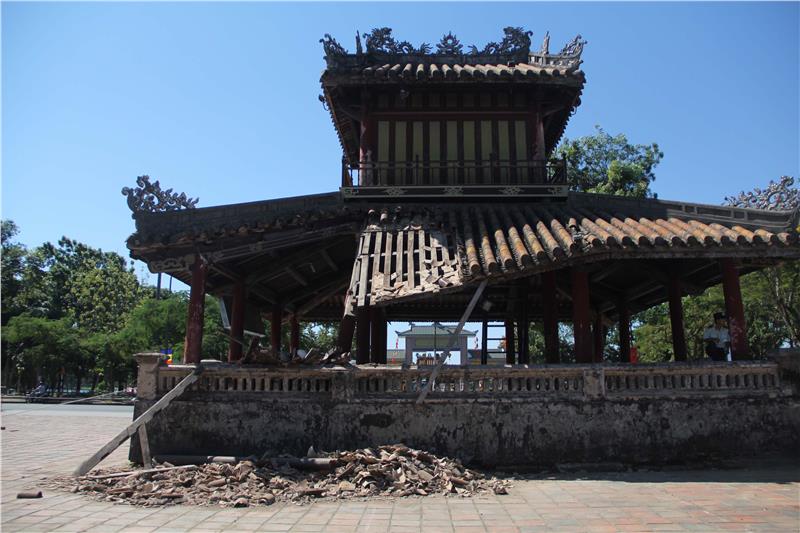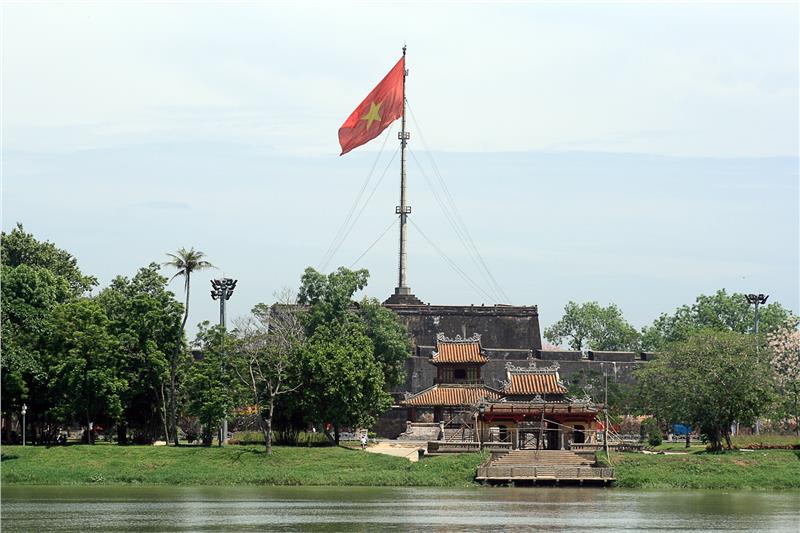Fri, 15 May 2015. Last updated Thu, 25 Jun 2015 09:06
| Mon | Tue | Wed | Thu | Fri | Sat | Sun |
|---|---|---|---|---|---|---|
Some days ago, Hue Monuments Conservation Centre organized the breakingground ceremony of Phu Van Lau Pavilion restoration in Hue Citadel. The work has the total investment captial of nearly 12 billion dong. Phu Van Lau Pavilion will be restored completely, including wooden frames and roof rig and silver carved decorative motifs, and yin-yang tiled roof... Phu Van Lau or Pavilion of Edicts is a two-floor architectural wooden work which was built in 1818 (the empire of the 17th Gai Long Emperor). The pavilion is the place of listing important royal edicts of Nguyen Dynasty and emperors, as well as the place of releasing the result of examinations held by the court. Under the power of emperors, Pavilion of Edicts was the venue of important parties.

Phu Van Lau Pavilion in Hue Citadel is situated on the Dung direction axis - the main axis of Hue Citadel. Seeing from Flag Tower towards Perfume River, there are two architectures coloring the appreance of Hue Citadel. One of them is Phu Van Lau (Pavilion of Edicts). Another is a small palace nearby Perfume River, also known as Nghinh Luong Dinh (Luong Dinh Welcome Pavilion). Along with the relics of Hue Citadel, Pavilion of Edicts possessing many values in terms of history, culture, and architectural art was recognized by UNESCO as World cultural heritage in 1993. Experiencing the ups and downs of time and weather, Pavilion of Edicts needs restoring. On May 15th, 2015, an angle of northeastern roof of Phu Van Lau collapsed. Currently, the work is being supported by steel pillar system, which may cause danger to visitors.

In early time of 1802 - 1819 under the empire of Giang Long, Phu Van Lau is a a small work called Bang Dinh in which king's and court's edicts were announced, as well as the place of releasing examinations' result. In 1819, Bang Dinh was replaced with a two-floor architecture with 16 pillars without walls, which creates an elegance and uniqueness with the name of Phu Van Lau (Pavilion of Edicts). In addition, Pavilion of Edicts is the place of issuing schedules and activities for local residents. Under the empire of Minh Mang, there was a decision that all edicts announced at Ngo Mon Gate or Thai Hoa Palace would be listed in Phu Van Lau.

In 1829, there was a fight between an elephant and a tiger in front of the pavilion, which attracted the attention of Minh Mang Emperor. On other important occasions, many interesting activities were held here. Later, emperors of Thieu Tri and Tu Duc also kept the customs. Thieu Tri Emperor considered Perfume River and Phu Van Lau as beautiful places among 20 beautiful landscapes in the citadel. In 1843, Thieu Tri Emperor ordered another work on the right of the pavilion. In 1904, the pavilion was collapsed by a storm. Then, Thanh Thai Emperor had the pavilion rebuilt.
Located in the main axis of Hue Imperial City, Phu Van Lau Pavilion makes Hue Citadel more ancient and taciturn. When visiting Phu Van Lau, visitors can drop by Luong Dinh Welcome Pavilion where they can take a rest here. Phu Van Lau Pavilion is a historical evidence of a patriotic emperor. The image of Phu Van Lau Pavilion used to printed on the back side Vietnamese bank note of 50,000 (2003).
Sorry, System is updating. Please, press SEARCH NOW

 Đặt vé máy bay cho người Việt?
Bấm vào đây
Đặt vé máy bay cho người Việt?
Bấm vào đây
Our service uses cookies for technical, analytical and marketing purposes. See our Cookie và Privacy policies for more information. If you agree to this, just keep browsing.
